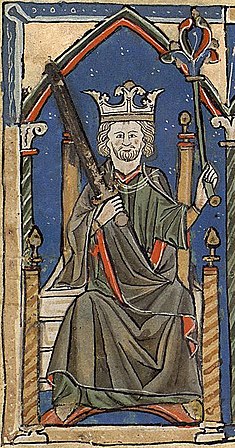Fernando II of Navarre
| Fernando II | |
|---|---|
 Fernando II depicted in a charter of 1171 | |
| King of Navarre, Aragon, and Valencia | |
| Reign | 23 August 1127 - 19 October 1177 |
| Predecessor | Fernando I |
| Successor | Fernando III |
| King of Aquitaine | |
| Reign | 17 June 1129 - 19 October 1177 |
| Successor | Fernando III |
| Born | 1 May 1113 Leyre, Kingdom of Navarre |
| Died | 19 October 1177 (aged 64) Rochechuart, Kingdom of Aquitaine |
| Burial | Catedral Real de Pampalona |
| Consort | Elisabeth von Silesia-Glogau (m. 1129; d. 1139) Urraca Jimena (m. 1146; d. 1177) |
| Issue | Fernando III of Navarre Erramun Fernandez, duke of Barcelona |
| House | Jimena |
| Father | Fernando I of Navarre |
| Mother | Patricia de Poitou |
Fernando II, known as Fernando the Wise (Fernando el Sabio; 1 May 1113 - 19 October 1177), was king of Navarre, Aragon, and Valencia from 1127 and king of Aquitaine from 1129 until his death. Fernando united the eastern Spanish kingdoms with the lands of the de Poitou family in Gascony and Poitou, crowning himself king of Aquitaine and creating a hybrid realm with Basque, Occitan, French, and Castilian cultural influences.
Fernando II spent large portions of his reign in managing domestic political conflict, but he also presided over the expansion of his domain over much of southern Iberia; he is remembered as the king who founded the Knights of Calatrava. In defensive wars against the kingdom of France and the Holy Roman Empire, Fernando wielded effective military power and managed to secure successful diplomatic outcomes.
Early life
Fernando Fernandez was born at Leyre on 1 May 1113, at his birth the only living son of Fernando I of Navarre and Patricia de Poitou, duchess of Gascony and Poitou. An elder brother, Prince Rodrigo, had died in 1110. The prince was kept at Leyre during his infancy. It was there on 14 June 1114, at the age of one, that he was presented with a coronet of opals and garnets and acknowledged as true heir by the nobles of his father's kingdoms. From about 1120 Fernando was raised at the castle of Pampalona and it is likely that he spent time in Gascony with his mother.
Fernando succeeded as duke of Gascony and Poitou after the death of his mother Patricia de Poitou on 1 May 1125. Aged twelve, he was invested as duke at St. Savin and provided Navarrese bodyguards. Real power rested in the hands of Gascon nobles such as Hughes de Lusignan and Bernat d'Armagnac. Fernando's cousin Carlos Ramirez, duke of Murcia and Valencia, enjoyed a similar rise to power as the widowed King Fernando I began losing his health.
Early reign
Fernando's father died at Jaca in Alto Aragón on 23 August 1127, leaving the duke of Gascony and Poitou as legitimate king of Navarre, Aragon, and Valencia. Duke Carlos Ramirez was nominated as regent of the three kingdoms by the "common acclaim" of the nobility. In the absence of any brothers of the young Fernando II he was also heir presumptive to the throne. The new king received three coronations at Pampalona, Barbastro, and Xàtiva, respectively. In 1128 the regency council, acting with the 15 year-old king, consolidated the de Poitou lands now in the hands of the crown by appointing French noblemen to the duchies of Bourbon, Gascony, and Poitou.
Establishment of power in Aquitaine
In the spring of 1129 Fernando attained his majority and assumed the full royal powers from Carlos Ramirez, not without resentment. On 17 June 1129 he arranged his own coronation as king of Aquitaine at Bayonne, reviving an old Carolingian title and asserting his claims to rule all of southern France. The coronation provoked violent opposition from Gunzelin von Zähringen, duke of Aquitaine, who had been recognized as lord of Aquitaine by the king of France. After warfare in 1129-30 the treaty of Cahors, signed on 12 March 1130, provided Fernando with formal recognition as king of Aquitaine.
In September 1130 Fernando arrested Carlos Ramirez for embezzlement and abuse of office. The duke was sent to prison in Nájera, where he remained until his death seven years later. In April 1131 the king travelled to Barcelona, where he replaced the incumbent duke Piarres Enekez with the child Alfons d'Urgell, a great-grandson of Prince Fernando Gartzez, brother of Antso IV. At an assembly of the nobles of Aquitaine convened at Poitiers in the autumn of 1131 Fernando was obliged to appoint the French dukes created three years earlier to dominant positions on his council. Chief among them were Archambaud the Confessor, duke of Bourbon, who became chancellor, and Hughes the Blessed, duke of Poitou. In 1132 a cousin of Archambaud de Bourbon, Aymer de Bourbon, was created duke of Auvergne.
Policy and family
The Poitiers assembly of 1131 indicated that Fernando was reliant on the nobility, in particular the Occitan and French lords inherited from his mother, to provide a foundation for his authority. During the 1130s Fernando remained unable to make policy without the support of acquiescence of these nobles. In 1133 he made a progress in Aquitaine during which he forced Duke Gunzelin to resign his lands to his vassal Alois de Perigord, an impressive display of the royal will. Until his death in 1138 the elderly Hughes the Blessed, duke of Poitou and head of the Lusignan family, was the preeminent lord in Fernando's French lands.
The alliance between the eastern and western branches of the Jimena dynasty was renewed in 1132 between Fernando and Alfonso VIII, king of Castile, León, and Galicia. Fernando was obliged to assist Alfonso in a Castilian holy war for the lands of Toledo, held by the Dhunnunid emirate, which raged from 1132 to 1139.
